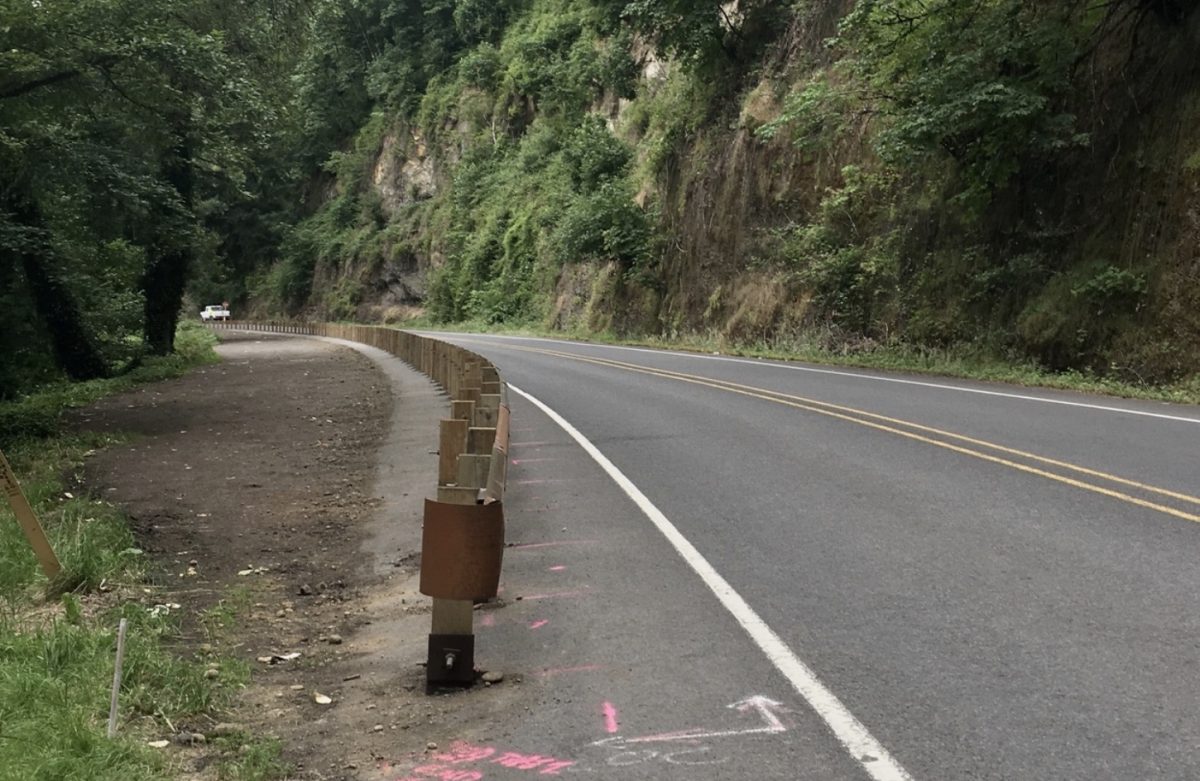
(Photos by BikePortland Forum user amadeusb4)
“We certainly understand how this effort reduces space available for bikers and other users…”
— Don Hamilton, ODOT
The Oregon Department of Transportation has narrowed the shoulder on several sections of the Historic Columbia River Highway. The installation of guardrails reduces space for cycling and increases danger for vulnerable road users on a very popular route along the Sandy River.
Earlier this month I noticed “No Parking” signs and barricades in several unpaved turnouts on the west side of the highway between Lewis & Clark State Recreation Area and the Stark Street Bridge. I assumed they were temporary measures to reduce crowds in line with the state’s Covid-19 response, or perhaps a way to discourage people from parking for several days without moving. Then last week BikePortland Forum user amadeusb4 noticed ODOT crews installing permanent guardrails.
“This is terrible for bicyclists!” amadeusb4 wrote. “I bicycle this often and always speed through the [existing] barrier sections because of the narrowness of the bike lane there. Now, most of the southbound side is going to have a barrier! While they will eliminate the occasional car backing out of a spot in front of a cyclist, they severely limit the amount of road available to bicycles to the right of the white line.”
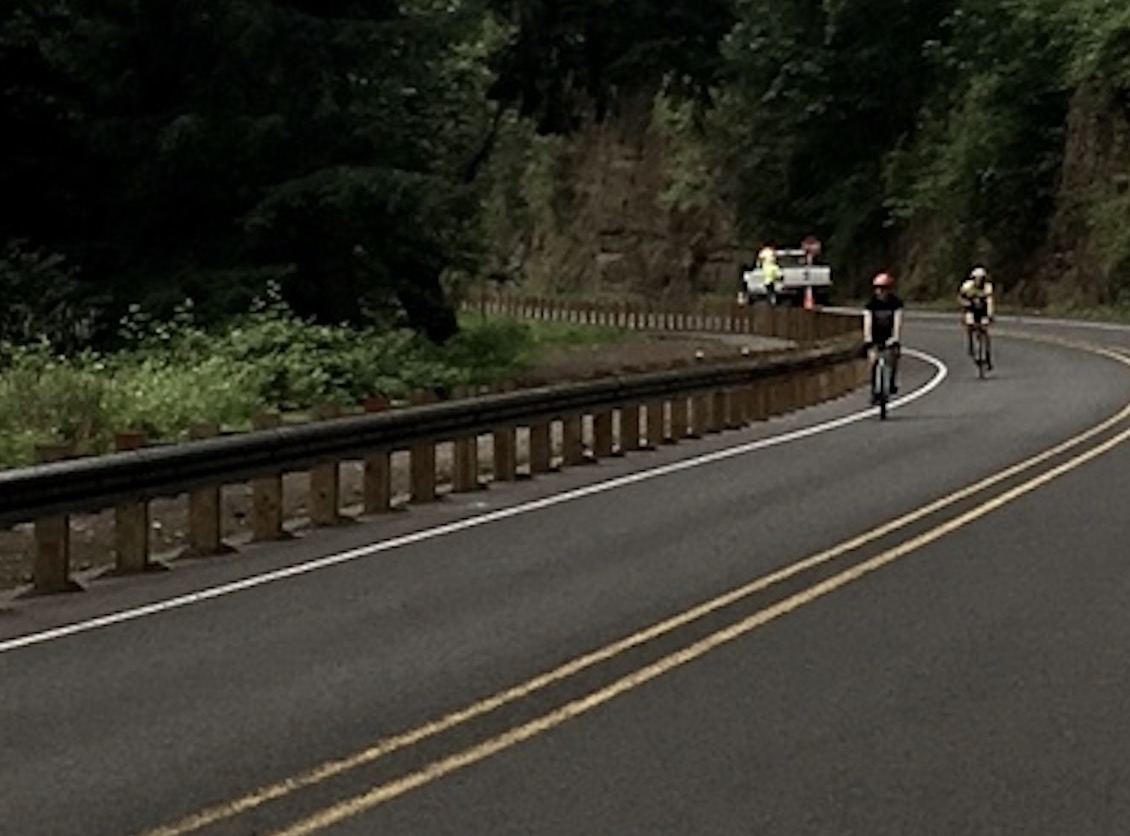
As you can see in the images, ODOT’s new guardrail was placed in the middle of the paved shoulder. This leaves bicycle users with about half the space they had before.
The new guardrails have been installed at three different locations each about 1,000 feet long. There was zero public notice prior to their installation.
The Historic Highway already has a few sections of guardrail in this same general area and (like amadeusb4 shared above) the reduced shoulder space definitely increases stress levels. The speed limit here is 35 mph and curves and context of the road make it a place where some drivers go much faster. This section of the highway is extremely popular because it’s relatively close to Portland (about 20 miles away) and a gateway to great roads in Corbett, the Columbia River Gorge, Larch Mountain, Sandy, and so on.
Advertisement
Asked about the project, ODOT Region 1 Public Information Officer Don Hamilton said his agency knows the guardrails will lead to less space for cycling, but he maintains they are necessary to deter illegal parking and camping along the shoulder. “We certainly understand how this effort reduces space available for bikers and other users,” Hamilton shared with us in an email. “But illegal campers were already causing problems by blocking the shoulders and sometimes the road and creating significant health and safety hazards, among them litter and other debris and refuse.” Because of this, Hamilton claims the guardrails make the road safer for bike riders.
Hamilton added that they tried to position the barrier closer to the edge of the shoulder but they weren’t able to because of a buried gas line.
This is a very unfortunate move by ODOT. They’ve taken a temporary problem (illegal parking behaviors) and introduced a solution that has a permanently negative consequence to our most vulnerable road users on one our state’s marquee cycling routes. This section of the highway is also part of Adventure Cycling Association’s Lewis & Clark Trail route.
This is not the first time the agency has made cycling demonstrably worse on rural roadways (or refused to improve them when given the opportunity). In just one example, in 2013 ODOT faced an outcry from advocacy groups after miles of shoulder on the famed Oregon Coast Bike Route were repaved in a way that left a dangerous ridge in the pavement. The work went against ODOT’s own statewide guidelines and they ultimately forced the contractor (whom they blamed for the error) to re-do the work.
BikePortland Forum user Alan_1.0 says what happened on the Historic Highway can’t be blamed on a contractor. “This strikes me as quite egregious,” they wrote. “Intentionally making the road more dangerous to vulnerable users, even though it is known as a popular ride.” Alan_1.0 thinks ODOT should have a process in place to review roadway modifications to make sure they don’t have a negative impact on vulnerable road users.
I’ve asked Hamilton if they’d consider caution signs warning drivers of reduced shoulder width and/or to expect the presence of bicycle users in the roadway. He said they’ll look into it.
If you have feedback on these guardrails, you can share it via Ask ODOT.
UPDATE, 7/6: ODOT admits these were a “mistake” and is removing them now. See latest story.
— Jonathan Maus: (503) 706-8804, @jonathan_maus on Twitter and jonathan@bikeportland.org
— Get our headlines delivered to your inbox.
— Support this independent community media outlet with a one-time contribution or monthly subscription.



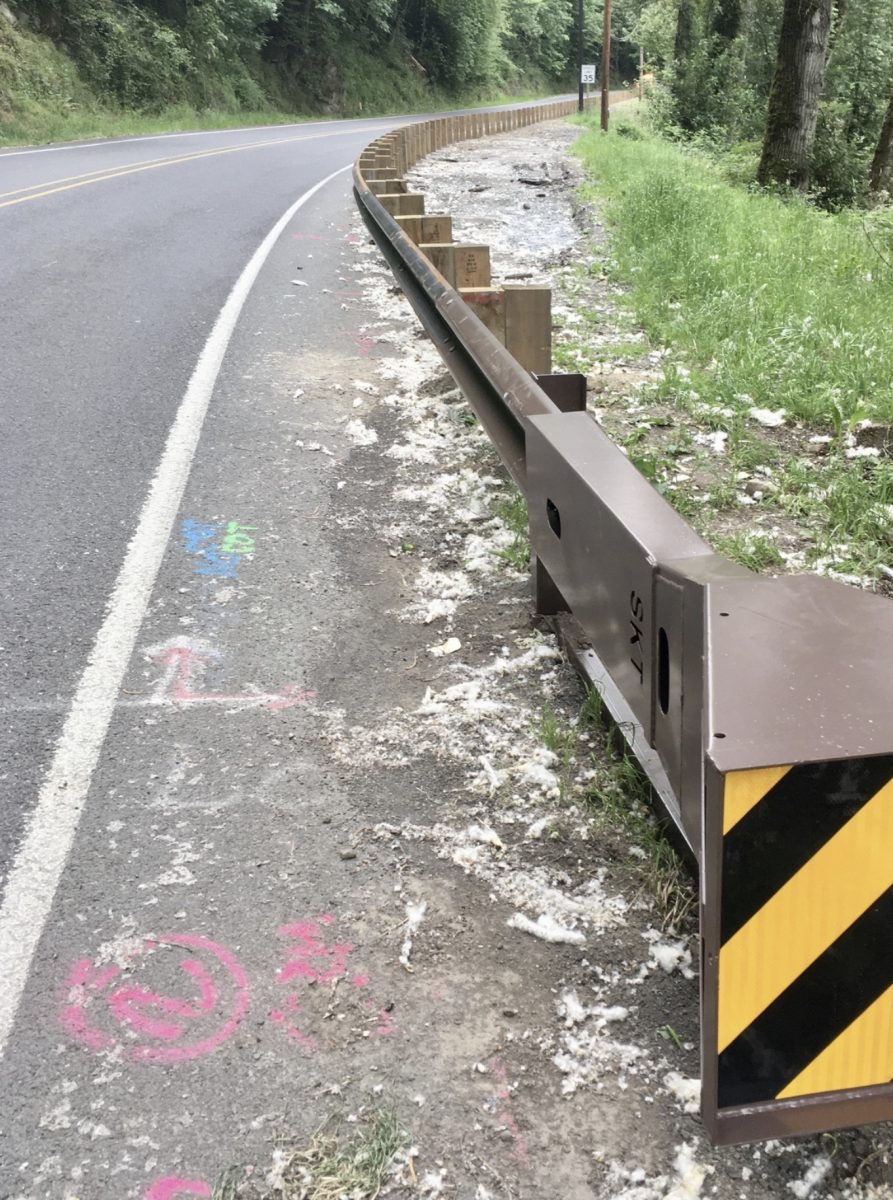
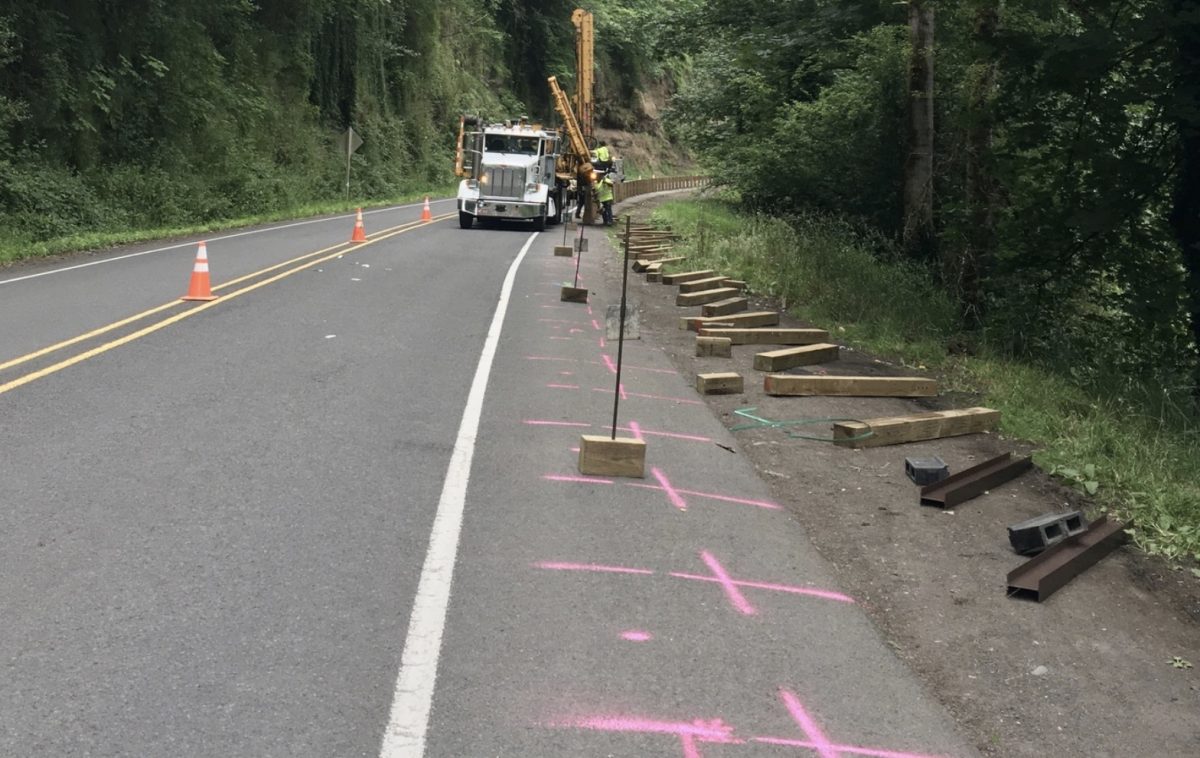


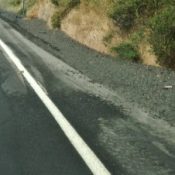
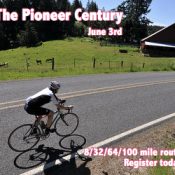
Thanks for reading.
BikePortland has served this community with independent community journalism since 2005. We rely on subscriptions from readers like you to survive. Your financial support is vital in keeping this valuable resource alive and well.
Please subscribe today to strengthen and expand our work.
Don Hamilton and the Region Manager should be required to ride that section of highway on bikes by themselves without a gaggle of press and law enforcement. Then they should publicly certify that it is safe.
I don’t like treating bike riding as any sort of punitive or corrective measure. It demeans riding. I would not mind one bit, though, if a subsequent review, redesign, and corrective construction to better-than-before riding conditions were funded out of the salary part of ODOT’s budget.
I live on this highway and have ridden it my whole life. Unless dynamite could be taken to the cliffs it is a very old narrow two lane highway with no designated bike lane and lots of curves with no shoulder room You ride at your own risk. Until ODOT put up their many guardrails a lot of people had accidents and died. Know that if you bike this highway it is at your own risk. It is not very safe.
There’s a huge difference between (1) bad drivers crashing themselves into the river and (2) intentionally creating a more dangerous condition for cyclists.
I’ve been reviewing ODOT’s Bicycle and Pedestrian Design Guide (Appendix L to the Highway Design Manual). The guard rail project is a total affront to the Design Guide. A couple quotes.
“Besides giving an area for cyclists to ride, paved shoulders are provided on rural highways for a variety of safety, operational and maintenance reasons such as:
– Motorists can stop out of traffic in case of emergency, or escape potential crashes; and
– Storm water can be discharged farther from the motor vehicle travel lanes, helping to
preserve the pavement.”
“In general, the shoulder widths recommended for rural highways in the ODOT Highway
Design Manual serve bicyclists well; HDM Table 7-2 should be used when determining
shoulder widths:
Average Daily Traffic 2000
Rural Arterials 4’ 6’ 6’ 8’
Rural Collectors 2’ 5’ 6’ 8’
Rural Local Roads 2’ 5’ 6’ 8’
Table 1-2: Rural road shoulder widths”
“On steep uphill grades, it is desirable to maintain a 6-feet (min. 5-feet) shoulder, as cyclists need more space for maneuvering.”
ODOT should tear out the guard rail since they implemented something in direct conflict with their own standards. Heads should roll.
Good start, but there is even more to support your argument in the ODOT Highway Design Maunal. For example:
1. Horizontal Stopping Sight Distance (for vehicles) – The guardrail on the inside of the curve appears to restrict sight distance to less than standard.
2. Shoulder width – Installation of guardrail requires an additional 2 feet of shy distance to the rail. (Also check your classification – this area might be urban.)
3. Gas Line – Utilities within highway right-of-way are usually there by permit and can be required to be moved. Assignment of cost is determined by OAR and CFR.
4. ODOT requires a “Design Exception” approval process to justify reasons when not meeting standards. A request for the project design plans and approved design exceptions should provide the justification.
Good luck.
A week ago I rode from the Stark St bridge up through Springdale and had two terrifying experiences with pick-up trucks coming intentionally close to me. One even came past twice. Both revved their engines when they were beside me.
I am very confused by ODOT making this route even more dangerous. This isn’t just a road where hardcore riders go out for a training ride. This is the access road to the Gorge bike/hike trail that will soon connect cyclists and hikers from Portland to Hood River without getting on 84. Is this expensive, show piece project with huge support going to be cut off by creating an area dangerous for cyclists to use at the main access point for the largest urban population center? Is there another way to get from Portland to the Gorge without a car/bus that I am not aware of? Seems incredibly short sighted.
I wonder how difficult, technically not bureaucratically, it would be to pave a path on the other side of the barrier? From the photos it looks easy enough.
My thought exactly! They’re already halfway to a protected bike lane!
It’s relatively easy, but you know as well as I do that they won’t do it.
A bike lane would also have deterred parking and might have been cheaper.
“Look into it”?
This has to have bikes in roadway warnings. That’s a uphill section — cars are going to be on our a$$ the whole way and we have no way to be safe other than jamming ourselves up against a barrier and hope to hell that no one side swipes us.
This is really, really bad.
They’ve done much the same thing in their improvements around Hagg Lake, though not sure it’s ODOT.
They actually blocked of trailheads with “upgraded” guard rails. 🙁
The roads around Hagg Lake are owned by Washington County, I believe
Hagg Lake is very safe to bike around. It is much better than it was years ago.
Ridiculous waste of taxpayer dollars. ODOT’s approach to mitigating homeless usage of state highway ROW is really stupid and expensive.
What a nightmare. I ride this route often, and the existing sections with barriers are already very taxing, sometimes forcing me to take the whole lane as I sprint to get beyond the hazard. Very tight spaces, most of them in turns. This road segment also reliably features aggressive drivers (looking at you, lifted truck dudes) who menace cyclists for amusement, putting my life at risk.
The lack of concern and/or basic understanding for the needs of cyclists from ODOT, and the comms you had with Hamilton there, border on belligerent. The reasons they claim for doing this are not remotely sufficient for the hazards they willfully create.
defund ODOT.
Let me guess; NIMBYs on the other side of the Sandy River didn’t want plebes like us to access the river from the highway? How nice it must be to own river-front property, and have a multi-billion dollar agency perform frivolous, exclusionary tasks such as this during a global pandemic, that make a classic cycling route even more dangerous, to boot.
Let me guess; you don’t actually know what those people are thinking.
you must not know anyone who owns waterfront. They want the rest of us off.
if buried gas lines prevented placing the guardrails further toward the road shoulder, why not place jersey barriers on the shoulder – those can be placed on top of buried lines.
feels like ODOT didn’t try very hard to avoid this because they don’t care very much
It looks like they are encouraging not discouraging camping. Before the guardrail, campers would need to worry about a car running off the road into their tent. Now with the guardrail the camping will be much lower stress.
A more effective approach would be to place boulders in the off-road dirt area, and leave the shoulder alone.
Does ODOT need to follow any public stakeholder process when doing something like this?
I live in the community (Corbett) and it’s definitely not a temporary problem. The illegal RV/car/vehicle situation had become quite a mess over the past couple of years. Apparently there may have been issues with dumping sewage from RVs right down toward the Sandy River. The illegal day parking (regular tourists) was crazy on sunny days north of I-84 and now guardrails are up there too, although almost no one cycles that spot. This wasn’t a NIMBY issue as far as I’m aware. I agree that boulders in those spots instead of a guardrail would have been much better for those of us pedaling the highway.
What you just described is literal NIMBYism.
NIMBYism isn’t always a bad thing. There are many things people don’t want in their neighborhoods, for good reason.
Right. And in this case, that desire has resulted in significantly more dangerous riding for all of us. Are you happy with the result?
I’m just saying that people throw it around as a pejorative when it isn’t always. There are a lot of negative things people don’t want in their neighborhood, and sometimes there is nothing wrong with that. Depends on what it is. Somehow, NIMBYism is just fine when it is a big box store or a chain restaurant.
As for “significantly more dangerous”…we really don’t know that yet. Have there been significantly more accidents already as a result?
NIMBYism is loudly cheered here often, particularly if it restricts access to neighborhoods — the more negative impact on anyone who drives the better.
If there’s one thing you can count on here, it’s support for reconfiguring public roads to effectively construct gated communities and redirect the traffic where those without clout live.
Are you talking about projects that create barriers to driving through parts of neighborhoods–say traffic diverters, or the Safe Streets Program that installed barriers to make some streets Local Access Only for vehicles?
If you are, I’d hardly call those “reconfiguring public roads to effectively construct gated communities”. I don’t know of any true gated communities that allow unlimited walking or biking through them, and especially none that encourage people to come TO those streets to walk or bike.
If you’re talking about something else…what?
You are either intentionally lying, or you haven’t spent more than 2 minutes reading about traffic diverters. I also question your understanding of gated communities.
It has been safer since installing the guardrails. Less people have died as they can’t go off of the road or cliff into the river.
That area between the Stark Street Bridge and the Troutdale Bridge has always been dangerous. With or without the guardrails people have died on that road. The guardrails make it safer. If you ride know that you ride at your own risk. Very narrow older highway with only 2 lanes and lots of curves and no shoulders on the curves. You ride at your own risk.
You drive at your own risk. Driving is the most dangerous thing you do every day.
Here’s an idea. Stage a weekly protest ride (Saturday or Sunday), Lewis and Clark to Dabney, where cyclist have signs stating the problem and what they want done, and TAKE THE LANE the whole way, maybe with a couple cars as escorts front and rear to minimize vehicular retaliation.
This is a stupid idea. The only way this problem can be corrected along the whole HISTORIC COLUMBIA RIVER HIGHWAY between the Troutdale Bridge and the Stark Street Bridge is to dynamite the cliffs. THE ROAD IS VERY NARROW…too narrow to put in a bike lane everywhere. If you go around the curve towards the Stark Street Bridge ODOT put a guardrail there with no way to ride unless you are on the road…because people have gone off the cliff there with their cars into the river and died. SO IF YOU BIKE YOU BIKE AT YOUR OWN RISK ON THIS HIGHWAY. I live there and it has been like this for 55 years.
Lori – cyclists are going to ride this section almost regardless of how poor its cycling infrastructure is – it is the only reasonable access from Portland to many of the best riding roads in the region. The qualm here is not that the road is not perfect for cyclists. We understand that the geology prohibits the shoulder/lane expansion we’d love to see, in a perfect world. The frustration/anger is the loss of some of the few stretches that were sufficiently wide for safe riding. These barriers could have easily been installed in such a way so as not to delete the bike lane.
Please stop bringing up the white wooden guardrails installed in curved sections of the road – totally different need and function, and are not what is at issue here.
Yes, we get it. You care more about the lives of bad drivers than the lives of cyclists.
Bad driver kill themselves by driving beyond their ability and going off the road into the ditch.
Now those bad drivers will live to run over cyclists instead.
We know your true feelings.
Beside narrowing the shoulder and making the ride less safe, the metal rail is not conforming with the historic white wood guardrails that reflect the historic character of the road. To discard the historic integrity of the HISTORIC COLUMBIA RIVER HIGHWAY to discourage illegal users is small minded and short sighted. Somehow I am not surprised
This has been one of my regular long rides. It was bad enough because of the aggressive local drivers that harass cyclists. This will make it much worse. Could they have put up temporary barriers and plant trees to stop illegal parking?
“We certainly understand how this effort reduces space available for bikers and other users”: Don Hamilton.
Translation: “We really don’t care what impact it has on cyclists or other users – we’re all about speeding up the cars.”
If you “understood” what impact it would have, why did you do it?!
ODOT sux!
Might another translation be racial and economic? “Bicyclist are mostly white and more likely to be higher-income and to have the free time to be exercising in this rural location, so we don’t care as much about them as our motor vehicle drivers and passengers, who are more likely to be blacks, Latinx, and Asians, poorer, and more likely be traveling to and from work.”
Theoretically it “might”. But ODOT’s history of running highways and freeways through poor and minority neighborhoods to facilitate commuting between suburbs and cities for wealthier and whiter commuters says it might not.
No. That area (zip code 97019) along the road is >90% white and median household income is $75668 per year: https://www.zipdatamaps.com/97019
Most jobs are white-collar: lots of exurban commuters.
Thank you for getting that info on here. After reading David’s post, I immediately thought “he obviously hasn’t traveled through this area”. Pretty much every aggressive pass I’ve had in that area, including a couple oncoming vehicles that veered over the center line in an apparent attempt to intimidate my riding group, have been from newer/nicer SUV’s and pickups.
The residents near this project are whiter and wealthier than your average cyclist.
I hope I can type another top-level comment. I’m hoping Jonathan can weigh in on this. As of last year there is a new law that requires a public agency that blocks or restricts river access to post a 30-day notice prior to taking the action:
https://olis.oregonlegislature.gov/liz/2019R1/Downloads/MeasureDocument/HB2835/Enrolled
The law doesn’t have a remedy stated, but it might bolster our moral case that ODOT’s actions were improper and unappreciated …
What happened to making this road one way with a contraflow bike/ped path? There were concrete plans announced by ODOT to test this out a year or so ago.
What the hell happened?
Covid-19 happened. ODOT, like all other state DOTs and most cities, lost a quarter of their annual gas tax revenue during the shutdown, and even right now with increased traffic, people aren’t driving as far as they used to, so they are using less gas and aren’t generating the revenue needed (the tax is based upon per gallons of gas sold, not miles driven.) And there’s a lot less interstate traffic (people driving into Oregon from other states). So now ODOT is focusing on just critical car safety projects, like guard rails, minor repaving, and bridge maintenance.
It’s much the same here in NC, except our DOT also made a $750 million error about keeping right-of-way they don’t need, so our Republican state legislature and Democratic governor have agreed to remove all state transit and bike/ped funding to complete unfinished freeway projects. Not that anyone in Oregon would give a shit.
I happen to know about that project and if it is the one I think it is, it is new highway construction and it tears through wetlands and nice countryside. Loss of open space anywhere is a “give a shit” situation and I do. Sorry for your loss
The one way idea was for the main waterfall (crowded) section of the HCRH. That would be from Larch Mountain Road to Ainsworth. I don’t recall the first 6-7 miles from Troutdale to Women’s Forum being part of the plan; far too many people living in that section to make it one-way IMHO
So ODOT is okay with potential dead cyclists in exchange for keeping the riff raff from camping on the side of the road? This is absurd and unnecessary, there are plenty of ways to accomplish the same result without putting lives in danger. This stretch is dangerous enough without essentially removing the bike lanes, I just hope I don’t end up becoming a ghost bike the next time I want to ride up Larch Mt. or out to the wonderful new trail sections in the gorge.
It is not just about that…people have driven their cars off the cliff into the river and have died. It is about public safety. Bike riders have to know that you ride at your own risk and have to be really careful. The guardrails are there for a reason. It is an OLD HIGHWAY for 100 years…no bike lane…no shoulder in spots…curves where you cannot see and out in the middle of nowhere if you get stranded and your phone dies.
So cyclists have to ride at their own risk but drivers don’t have to drive at their own risk? And it’s OK to make it more dangerous for cyclists if it makes it safer for bad drivers?
Careful, you’re letting your true colors show through.
I live along this highway…and without taking dynamite to the cliffs and destroying the homes and properties of people that have lived here for generations….these guardrails serve a very important purpose: TO PROTECT THIS HISTORIC COLUMBIA RIVER HIGHWAY. There are many other places to ride that are safe and this highway is not one of them. You must ride here knowing that you ride at your own risk. There are many guardrails that have to exist so that cars do not go off of the cliff into the Sandy River and for other reason…and that if ODOT erects guardrails it is for very important safety concerns. IT IS A NARROW TWO LANE HIGHWAY with very little shoulder in some spots. It can be very desolated and unsafe should you get a flat tire and are stranded and unable to fix it.Please have some respect for ODOT.
The barriers don’t protect the road.
So cyclists have to ride at their own risk but drivers don’t have to drive at their own risk? And it’s OK to make it more dangerous for cyclists if it makes it safer for bad drivers?
There are other places to drive. How safe are you going to feel changing a flat tire on your car while you’re parked in the middle of the lane because there’s a rail preventing you from pulling over?
Careful, you’re letting your true colors show through.
This highway is not on the ODOT Safety Corridor list: https://www.oregon.gov/odot/Safety/Documents/SafetyCorridorMasterList.pdf
Your comment of the need for a shoulder for breakdowns is also a case for effective bike lanes, not for guardrails.
People riding their bicycles have as much right to highways as anyone, I should not have to risk my life for this privilege.
I am a homeowner along the Historic Columbia River Highway and have lived there since 1964. Everyone along this highway greatly appreciates the new guardrails installed .
I have ridden my bike from the Stark Street Bridge to the Troutdale Bridge my whole life and with its many curves it is not the safest place to ride a bike.
There are many other better places to ride.
I am attaching a photo of the guardrails recently installed less than 1/2 mile – 1 mile from the new guardrails that were just installed due to safety concerns and they also have very little room between the road and the guardrails. BUT THEY MUST BE THERE TO PROTECT EVERYONE’S SAFETY, just like the NEWEST GUARDRAILS PROTECT THE HISTORIC COLUMBIA RIVER SCENIC HIGHWAY, and the SAFETY OF THE LOCAL COMMUNITY.
There are three parks within 2 miles. Otto Park, Dabney Park, and Lewis and Clark Park. All of which have restrooms and are designed for the public. This area where the newest guardrails were just installed is not a park. The river banks are steep and out of view from the road which is perfect for the homeless who are often mentally ill, doing drugs and disposing of their human waste, garbage, and drug paraphernalia along the river banks and road. Until the guardrails were installed it was a public dump, a place to live and sleep out of view from the public yet be able to park their vehicles next to where they are camped out. It provided a dangerous element to this scenic highway.
This area is a HISTORIC SCENIC AREA without the guardrails it is unprotected from public destruction.
Anyone on a bike needs to see a sign saying WARNING NO ROAD SHOULDER AHEAD.
Without taking dynamite to the cliffs which would be impossible….BIKEPORTLAND.org needs to know there are too many curves, no designated bike lanes, not enough shoulder on the road, and for the safety of the surrounding communities, and to perserve this scenic highway… these guardrails needs to be kept in place. They need to understand that this is a scenic area and that they can enjoy it by car now that that the new guardrails are in or BIKE AT YOUR OWN RISK with SMALL OR NO ROAD SHOULDERS.
Loosing a foot or two of paved shoulder that allows cyclists to safely navigate these specific curves is a big deal for all road users. As you said, this is a narrow road, a historic scenic highway, and this section of the road, where speeds are higher, can be unsafe at times for cyclists and motorist alike. I don’t think you’ll get much argument there. But cyclists have a right to be on the road, and I think you will find that forcing cyclists further to the left into this specific roadway will only cause more conflicts. If ODOT took a second to think about this and positioned the new barriers a foot or two to the right, taking whatever engineering/construction affordances for this purported buried infrastructure, I think most readers would be fine with the additional barriers.
I have been riding narrow rural roads for 20 years, dealing with this type of car centric, frankly homicidal mentality towards cyclists. I’m used to it and I won’t stop riding these roads. I will do as I always do and ride as far right as is safe and hope someone like you does their due diligence as a fellow citizen, driving safely and in control of their vehicle, allowing me to continue to live to ride another day.
Please stop driving. Your attitude is disturbing and you are a dagger to others.
Yes, we’ve heard it all before. Your precious neighborhood is more important than the others that you just moved this problem to. I’m sure your neighbors beyond the rails hate you for forcing the campers into their precious neighborhood. Congratulations on solving nothing.
You’ve stopped bad drivers from losing control of their vehicles and suffering the consequences while making it much more dangerous for an already vulnerable subset of road users.
You sound like a horribly selfish person. You and your neighbors may have succeeded in making it worse for everyone. Now drivers will be stuck behind cyclists who have nowhere else to ride except in the middle of the lane, where they’re supposed to be but are usually polite and move over for drivers.
UPDATE, 7/6: ODOT admits these were a “mistake” and is removing them now. See latest story.
I rode this section earlier in the week, and found it to be no better or worse than it was previously. In this way it’s similar to most other portions of the HCRH, and in fact just about every other rural road riders will be on, where the major risk comes from cars passing too closely. In other words, that can happen anywhere. The road is still awesome, and the short time it takes to bypass these guardrails is simply not a big deal.
I live in troutdale, and drive hwy 30 daily. The garbage and homeless are out of hand. I did not see the guard rail as the best option. But it was something to clean it up. For the cyclist, they are ALL thinking they own the road! They need to register their bikes just like boats, ATV, motorcycle, kyake, and cars. Untill they pay, use the spring water trail. U want rights? Pay like everyone else.
I, like probably most cyclists, own a car (actually two) so I’m already paying. And when I’m riding, I’m causing zero wear and tear on the roads. What else ya got?
Thank u for responding and not being rude. You are correct, o wear on the road. BUT 100 Percent of cycling on hyw 30 is not safe. As others claim, u need 3 feet of the road. Not one place has that.
I have a question for you…. You claim no damage to the road? What about all the lanes painted green? Who pays for that? Takes lanes from drive lanes? Look forward to your response. Thank you.